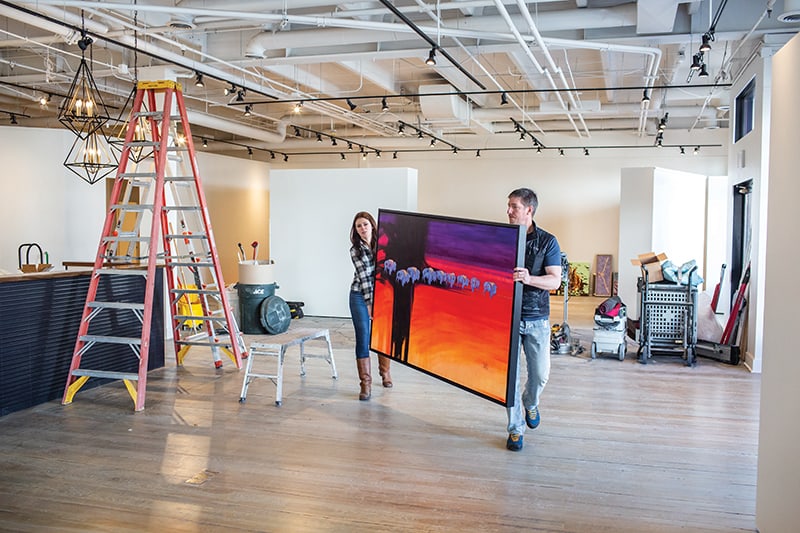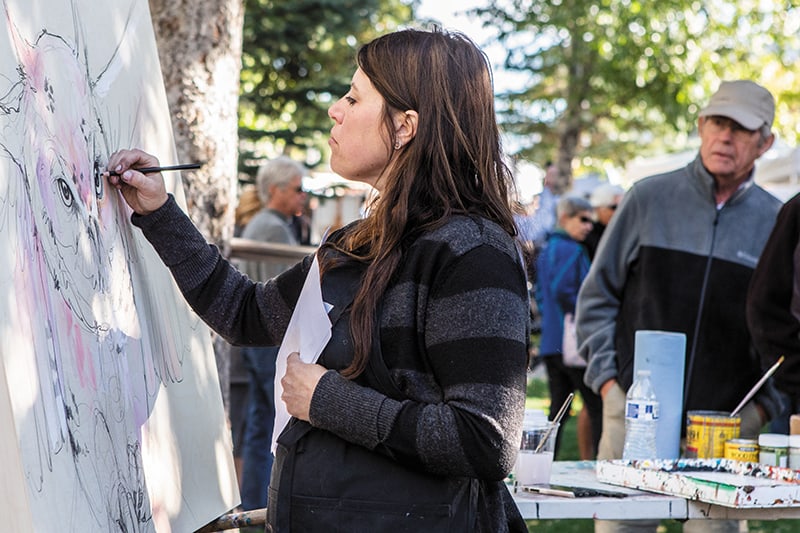Read The
Current Issue
Mixing Business with Art
Artist-owned galleries add to Jackson Hole’s creative scene.
By Samantha Simma

Jim Wilcox, center, chats with Jeanette “Moosie” Woodling and Cliff Poindexter last July during a 50th anniversary party at his Wilcox II Gallery on the Town Square. Photo by Ryan Dorgan
THE WILCOX GALLERY features landscape paintings by Jim Wilcox, a Jackson-based painter who has been invited to participate in the National Cowboy & Western Heritage Museum’s prestigious Prix de West Invitational Art Exhibition 36 times. He was awarded the show’s biggest honor, the Prix de West Purchase Award, once, and its Frederic Remington Painting Award twice. But his galleries—Wilcox Gallery has two locations, one just north of town and one on Town Square—do not display his work exclusively. Wilcox Gallery represents about forty other artists, from portrait painter Judith Dickinson to Gerald Griffin, who sculpts and does still life paintings. When considering what artists to represent, Wilcox says he looks for works that are “high-quality, priced appropriately, and compatible with the rest without overlapping.”
While 2019 marked the 50th anniversary of Wilcox opening his gallery, he didn’t plan on being a gallerist. In the late 1960s he was a painter in the valley looking for a gallery to represent his work. At the time, there was only a handful of galleries, two of them run by artists who did not show work that was not their own. “The other gallery didn’t have room for me,” Wilcox says.
In early summer 1969 Wilcox and his wife Narda saw a building in downtown for rent. “We decided we could handle $100 a month in rent,” Wilcox says. “It was a shoebox—about twelve-by-sixteen feet.” However, that season proved successful enough that the Wilcoxes were able to rent a bigger space the following summer. “We laid carpet ourselves, put burlap on the walls ourselves, did lights ourselves, and started carrying other artists’ work,” Wilcox says. “I would have had trouble filling the space [with my own work]. I thought the gallery would do better with variety and, as an artist, I wanted to be exposed to other artists. You can’t be an artist and see other people’s work without learning something.”
Since then, the Jackson Hole gallery scene has changed dramatically. Other valley artists have followed in Wilcox’s footsteps and opened their own galleries. For instance, painter Amy Ringholz opened Ringholz Studios in 2014. Painter Kathryn Mapes Turner opened Trio Gallery with two other artists in 2004 and, in 2018, renamed it Turner Fine Art when she became the gallery’s sole owner. And painter Carrie Wild opened Gallery Wild in 2018.
This doesn’t surprise Wilcox. Jackson has grown “from a little western town with a few artists to being the center of western art,” he says. The National Center for Arts Research backs him up: Its 2019 annual ranking of the country’s most arts-vibrant cities combined Jackson Hole and Teton Valley, Idaho, calling the area number-one for small cities.
Turner, who in 2019 was invited by the prestigious Salmagundi Club to exhibit in its annual American Masters exhibition in New York City, says, “The gallery scene here in Jackson Hole is something the whole community can be proud of. It is up there with Santa Fe, San Francisco, and New York. It’s a group effort and each gallery contributes something different. Our artist-owned galleries allow collectors to talk to the artist
directly about their process and motivation, and learn the story behind the piece.”
IT WAS THE opportunity to interact with collectors and the public that inspired Wild, who paints contemporary pieces of wildlife subjects, to open her gallery. In 2012 she began participating in events and shows where, she says, “I was actually able to witness expressions on viewers’ faces. Whether it was a smile with a gasp of excitement or a scoff of disgust from someone who preferred a more traditional representation [of wildlife], I found I enjoyed engagement with people. As I enjoyed these interactions more and more, just dropping my work off at a gallery and saying ‘good-bye’ to it didn’t feel like enough.”
Turner feels the same way: “I don’t love sending work off and getting a check in the mail. It feels very unfulfilling. I want to meet the people that take a piece of me home with them and make it a part of their lives.”
For Ringholz, interacting with collectors and the public is about exposing them to her process. “I enjoy making work around an audience because I like for them to see the authenticity in my skills and my process,” she says. “People love to watch behind-the-scenes painting and I enjoy delivering that to them.”
Another benefit to artists who own a gallery is freedom. Turner says that when other galleries represented her art she was asked to work within the confines of specific requests. “They would say, ‘I only want your horses’ or ‘I only want landscapes.’ As an artist, it’s hard to work that way.” Since she’s represented herself, Turner says, “I can paint what is moving me at any time. Of course, I’m assuming all the risk then—financial, and I’m making myself vulnerable trying new things in the public eye—but for me it is critical that I keep all of my creative options open.”
Last winter, after Wild painted a piece for Jackson Hole Mountain Resort’s Solitude Station with softer, more delicate colors than the vibrant, jewel-toned colors she was known for, she wanted to continue to explore this palette. Because she owned her gallery, she could do this. She does the majority of her painting in her gallery, so she was also able to see how people reacted to her new colors. “I found that as I painted with the softer colors, onlookers responded to them just as much as they did to the bright colors,” she says. You’ll now find her paintings with both palettes in Gallery Wild.
BUT YOU WON’T see just Wild’s paintings in her gallery. Like Wilcox, she finds inspiration in the work of other artists, and thinks variety helps her gallery’s bottom line. “I consider myself a collector, and I can’t imagine not being surrounded by some of my favorite artists’ work in the gallery,” she says. “Having other artists’ work alongside mine helps provide a complete package for our visitors. Collectors may find an artist that they really love and enjoy and will have several pieces of, but not very often do they only collect just one artist.” When selecting artists to represent, Wild looks for ones who are “fresh and new to Jackson Hole” and who “complement each other but don’t compete with each other.” More than half of the artists showing work in Gallery Wild had never before been represented in the valley.
Turner says she “loves representing and working with other artists. Having the opportunity to provide them space to share what they’re working on is one of my favorite things about having a gallery.” She also enjoys being surrounded by the work of other artists. “It’s a regular infusion of creativity coming through the doors.” Her gallery represents artists who “have a relationship with the natural world and use that to drive their work. I personally never would want to have the gallery be just my work, but I do want there to be a common thread among the artists.” Since Turner’s work is so inspired by the natural world, it makes sense for that to be the common thread in her gallery.
Ringholz Studios opened as a 1,000-square-foot gallery in 2014 and moved to a larger space on Broadway Avenue in 2019. In contrast to the other galleries featured here, it does not carry work by other artists. Ringholz maintains that this has made her a better and different artist than if her gallery did represent other artists. “I try to look like I am several different people within one room,” she says. “If my work was too similar it would be overwhelming, or repetitive and dull. Using different mediums and subjects, I am able to bounce from watercolor to oil to drawings on wood, and this allows me to keep pushing myself. I like the challenge of filling an entire space with my creativity and figuring out how to stay relevant and exciting as a one-man shop.”
Whether or not a gallery is a one-woman shop, or artist-owned or not, Wild says, “Art galleries as a whole are important. Having a strong art presence with a lot of selection and variety within Jackson Hole is important for our art scene and will guarantee that the arts thrive here. One gallery can’t represent everyone. Having multiple galleries gives talented artists a way to be a part of our art culture and gives their art a good home. It also helps to make gallery walking a full-day activity for Jackson Hole visitors.” JH

Painter Amy Ringholz’s new gallery in downtown. Photo by Rebecca Noble

Carrie Wild and her husband Jason Williams move one of Wild’s paintings into Gallery Wild, which the artist herself owns. Photo by Ryan Dorgan

Kathryn Mapes Turner’s work is inspired by the natural world around her. When selecting others to represent, she looks for artists who also draw inspiration from their natural surroundings. Photo by Teri Moy

A first step for some local artists who went on to open their own galleries was to participate in an open-to-the-public painting event—like the QuickDraw, pictured here. They say they enjoyed the interaction with the public and being able to share their process. Photo by Amber Baesler




